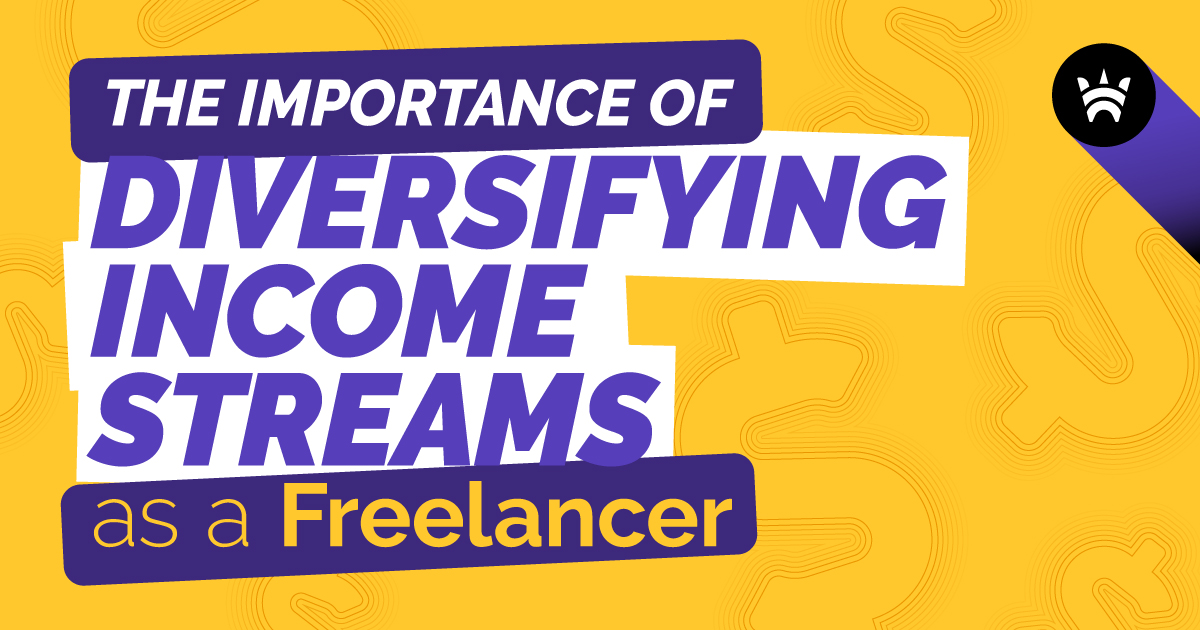
4 Ways to Diversify Your Freelance Income Stream
4 Ways to Diversify Your Income Stream as a freelancer or agency – that’s the holy grail for anyone working independently, right? The fear of relying on a single client or project is real, but the good news is that there are plenty of smart strategies to build a more resilient and profitable business. This post dives into four key areas to help you expand your offerings and secure your financial future, transforming your freelance hustle into a thriving enterprise.
We’ll explore diverse service offerings, targeting specific client niches, leveraging online platforms, and even creating and selling your own digital products. Get ready to supercharge your income!
Whether you’re a seasoned freelancer or just starting out, diversifying your income is crucial for long-term success. It’s not just about making more money; it’s about creating a sustainable career that’s less vulnerable to market fluctuations and client cancellations. By exploring different avenues for income generation, you’ll gain a competitive edge, reduce risk, and ultimately build a business that truly works for you.
Developing Multiple Service Offerings
Diversifying your income stream as a freelancer or agency is crucial for stability and growth. Offering multiple services, complementary to your core offerings, expands your market reach and reduces reliance on a single income source. This strategy allows you to cater to a wider range of client needs and increase your overall earning potential. By strategically adding services, you can leverage existing skills and attract new clients while building a more resilient business.
Complementary Services for Freelance Graphic Designers
A freelance graphic designer specializing in logo design can significantly increase their income and client base by offering related services. This expands their service portfolio and allows them to provide comprehensive branding solutions to clients. The following table illustrates three such complementary services.
| Service | Description | Target Audience |
|---|---|---|
| Branding Guidelines | Creates a comprehensive document outlining the brand’s visual identity, including logo usage, color palettes, typography, and imagery. Ensures consistent brand application across all platforms. | Businesses seeking consistent brand application across marketing materials and online presence. |
| Website Design | Designs visually appealing and user-friendly websites that reflect the brand’s identity. May include elements like UI/UX design and responsive design. | Businesses needing a professional online presence and a cohesive brand experience. |
| Social Media Graphics | Creates visually engaging graphics for social media platforms, maintaining brand consistency and enhancing social media marketing efforts. | Businesses looking to improve their social media presence and engagement. |
Service Packages for a Digital Marketing Agency
Offering various service packages allows a digital marketing agency to target different client needs and budgets, maximizing revenue and client acquisition. These packages should be clearly defined and priced to attract a diverse clientele.
Here are five distinct service packages a digital marketing agency could offer:
- Basic Package: Includes research, on-page optimization, and local citation building. Targets small businesses with limited budgets.
- Social Media Management Package: Focuses on content creation, scheduling, and community engagement across various platforms. Suitable for businesses aiming to increase brand awareness and engagement.
- Comprehensive Digital Marketing Package: Combines , social media management, and paid advertising (PPC) for a holistic approach. Appeals to businesses seeking significant online growth.
- Email Marketing Package: Develops and implements email marketing campaigns to nurture leads and drive conversions. Ideal for businesses with established email lists.
- Website Design & Development Package: Provides a complete website solution, including design, development, and optimization. Targets businesses needing a new website or website overhaul.
Diversification for Freelance Writers
Freelance writers can expand their service offerings beyond blog posts by leveraging their writing skills in diverse areas. This approach allows them to cater to a broader client base and increase their earning potential. Copywriting, technical writing, and grant writing are three examples of such diversification.
The following description compares the skill sets required for each service:
Blog Post Writing: Requires strong storytelling abilities, knowledge, and an understanding of target audience engagement. Focus is on creating engaging and informative content for online audiences.
Copywriting: Emphasizes persuasive writing to drive sales or specific actions. Requires a deep understanding of marketing principles and the ability to craft compelling calls to action. Focus is on achieving specific marketing goals.
Technical Writing: Demands precision, clarity, and a strong understanding of technical concepts. Requires the ability to explain complex information in a simple and accessible manner. Focus is on accurate and easily understandable documentation.
Grant Writing: Requires meticulous research, persuasive writing, and a strong understanding of grant application requirements. Focus is on securing funding for organizations or projects through compelling proposals.
Targeting Diverse Client Niches

Source: beewits.com
Diversifying your income as a freelancer or agency often hinges on strategically targeting various client niches. This approach not only reduces reliance on a single client base but also allows you to leverage your skills in different contexts, leading to a more robust and resilient business. By understanding the specific needs and challenges of each niche, you can tailor your services and marketing efforts for maximum impact.
Freelance Web Developer: Three Distinct Client Niches
A freelance web developer can find success by focusing on distinct client needs. Three such niches, each presenting unique opportunities and hurdles, include e-commerce businesses, non-profit organizations, and startups. E-commerce businesses require developers skilled in building user-friendly online stores with robust shopping cart functionality and secure payment gateways. Non-profits, on the other hand, often need websites that are informative, easy to navigate, and effective at fundraising or volunteer recruitment.
Startups, typically operating with limited budgets, need developers who can create scalable and adaptable websites within their financial constraints.
Freelance Photographer: Two Underserved Industries and Penetration Strategies
The freelance photography market, while competitive, presents opportunities in underserved sectors. Two such areas are the agricultural industry and the manufacturing sector. Agricultural businesses often lack high-quality imagery for marketing and branding purposes, and manufacturing companies could benefit from professional photography to showcase their products and processes. Successfully penetrating these markets requires a strategic approach.
So, you’re a freelancer or agency looking to boost your income? Diversifying is key – think affiliate marketing, online courses, selling digital products, and even creating your own YouTube channel! Check out this awesome guide on getting it on with YouTube to learn how video marketing can seriously level up your 4 ways to diversify your income stream.
Once you’ve mastered that, you’ll be well on your way to building a truly resilient income stream.
To successfully penetrate these markets, a freelancer should consider these steps:
- Market Research: Thoroughly research the specific needs of agricultural and manufacturing businesses regarding photography. This includes understanding their marketing goals and the types of images they require (product shots, process documentation, lifestyle imagery).
- Targeted Marketing: Develop a targeted marketing campaign focusing on these industries. This might involve attending relevant trade shows, networking within industry groups, and creating a portfolio showcasing relevant photography samples.
- Building Relationships: Establish relationships with key decision-makers in these industries. This could involve reaching out directly to businesses, attending industry events, or collaborating with other professionals who serve these clients.
- Specialized Skills Development: Invest in developing specialized skills relevant to agricultural and manufacturing photography. This might involve learning about specific equipment or techniques needed to capture high-quality images in these environments.
Freelance Consulting: Marketing Strategies for B2B and B2C Sectors
Marketing to businesses (B2B) differs significantly from marketing to individual consumers (B2C). A freelance consulting business needs distinct strategies for each. B2B marketing relies heavily on building trust and demonstrating expertise. This often involves networking, content marketing (such as white papers and case studies), and participation in industry events. B2C marketing, on the other hand, might focus more on building brand awareness through social media, online advertising, and testimonials.
A crucial difference lies in the decision-making process; B2B sales often involve multiple stakeholders and a longer sales cycle, while B2C decisions are typically made by individuals more quickly.
Leveraging Online Marketplaces and Platforms
Online marketplaces and platforms offer a powerful avenue for diversifying your freelance or agency income. They provide access to a vast pool of potential clients you might not otherwise reach, allowing for significant expansion of your business. However, it’s crucial to understand both the advantages and disadvantages before diving in. Strategic utilization is key to maximizing the benefits and mitigating the risks.
Advantages and Disadvantages of Freelance Platforms
The decision to utilize platforms like Upwork and Fiverr involves weighing various factors. A clear understanding of both the pros and cons is essential for informed decision-making.
| Advantages | Disadvantages |
|---|---|
| Large pool of potential clients: Access to a global market significantly expands your reach beyond your existing network. | High competition: You’ll be competing with numerous other freelancers, often leading to lower prices and tighter margins. |
| Built-in payment system: Secure and reliable payment processing simplifies transactions and reduces administrative overhead. | Platform fees: A significant portion of your earnings goes to the platform as commission, impacting your overall profit. |
| Established reputation system: Client reviews and ratings build credibility and attract more clients over time. | Client management challenges: Dealing with a large number of clients from diverse backgrounds can be time-consuming and demanding. |
| Easy to get started: Setting up a profile and listing your services is relatively straightforward. | Potential for scams: It’s important to be vigilant and cautious to avoid fraudulent clients or projects. |
| Exposure to various project types: You can diversify your skillset and experience by taking on different types of projects. | Dependence on the platform: Your income stream is tied to the platform, making you vulnerable to changes in their policies or algorithms. |
Strategy for a Freelance Translator Utilizing Multiple Online Platforms
A freelance translator can leverage multiple platforms to reach a broader audience and increase their income potential. A well-structured strategy involves a phased approach focusing on platform selection, profile optimization, and consistent engagement.
- Phase 1 (Weeks 1-4): Platform Selection and Profile Creation: Choose at least three platforms catering to translation services (e.g., Upwork, Fiverr, Gengo). Create compelling profiles highlighting language expertise, specializations, and previous experience. Include high-quality samples of your work.
- Phase 2 (Weeks 5-8): Bid on Relevant Projects: Actively bid on projects that align with your skills and experience. Tailor your proposals to each client’s specific needs, emphasizing your unique qualifications. Maintain a high response rate and strive for prompt communication.
- Phase 3 (Weeks 9-12): Client Relationship Management: Prioritize client satisfaction by delivering high-quality translations on time and within budget. Actively solicit feedback and testimonials to build a strong reputation on each platform.
- Phase 4 (Ongoing): Platform Optimization and Expansion: Continuously monitor your performance on each platform, adjusting your strategies as needed. Consider expanding to other relevant platforms or niche markets to further diversify your income streams. Explore offering additional related services, such as proofreading or editing.
Examples of Online Platforms for Freelancers
Different platforms cater to specific skills and client needs. Choosing the right platforms is critical for maximizing your success.
Selecting the appropriate platform depends heavily on your skillset and target market. Some platforms specialize in specific niches, while others offer a broader range of services.
- Upwork: A large platform offering a wide range of freelance services. It’s ideal for experienced freelancers seeking diverse projects and long-term collaborations. Target audience: Businesses and individuals seeking various professional services.
- Fiverr: Known for its gig-based model, Fiverr is popular for smaller, more specific tasks. It’s a good option for freelancers starting out or offering specialized services. Target audience: Individuals and small businesses seeking quick, affordable solutions.
- Guru: Similar to Upwork, Guru connects freelancers with clients across various industries. It offers a project management system and secure payment processing. Target audience: Businesses and individuals seeking a wide range of professional services.
- Toptal: This platform focuses on highly skilled freelancers in tech and design. It’s known for its rigorous screening process and high-paying projects. Target audience: Businesses seeking top-tier talent for complex projects.
- PeoplePerHour: PeoplePerHour allows freelancers to create hourly or project-based offers. It’s suitable for freelancers who prefer flexible working arrangements and diverse project types. Target audience: Businesses and individuals seeking both short-term and long-term projects.
Creating and Selling Digital Products or Courses
Diversifying your income as a freelancer or agency often involves exploring avenues beyond client projects. Creating and selling digital products or online courses is a powerful strategy to generate passive income and build a stronger brand presence. This approach allows you to leverage your existing skills and expertise to create valuable resources that cater to a wider audience.
Creating and Selling an Online Course on a Freelance Skill
Developing and selling an online course requires a structured approach. First, identify a highly sought-after freelance skill where you possess significant expertise. Thoroughly research the market to understand the demand and identify any gaps in existing course offerings. Next, create a detailed course Artikel, breaking down the skill into manageable modules. Each module should contain video lectures, downloadable resources, and interactive exercises to enhance the learning experience.
Platforms like Teachable, Thinkific, and Udemy offer robust tools for course hosting, marketing, and sales. Effective marketing involves leveraging social media, content marketing (blog posts, articles), email marketing, and paid advertising to reach your target audience. Pricing strategies should consider the course’s value, market competition, and your target audience’s willingness to pay.
Digital Products for a Freelance Graphic Designer, 4 ways to diversify your income stream as a freelancer or agency
A freelance graphic designer can create and sell a variety of digital products to expand their income streams.
- Pre-designed Social Media Templates: These templates can be tailored to various social media platforms (Instagram, Facebook, Twitter) and include customizable elements like logos, fonts, and color schemes. The target audience is small businesses and social media managers who need visually appealing content without the time or resources to create it from scratch. They could be sold individually or in bundles based on platforms or themes.
- Customizable Font Bundles: Creating and selling unique font bundles offers a significant advantage. The target audience includes graphic designers, web designers, and businesses looking for a cohesive brand identity. Font bundles can be themed (e.g., handwritten fonts, modern sans-serif fonts) or offer a range of styles to suit various design projects. The pricing strategy could involve tiered pricing based on the number of fonts included.
- High-Quality Stock Photos: Offering stock photos relevant to specific niches (e.g., food photography, lifestyle imagery, product shots) can attract a broad audience of bloggers, website owners, and marketing professionals. The key is to create high-resolution images that are visually appealing and on-trend. Pricing can be based on individual downloads or subscription-based access to a library of images.
Creating and Selling an Ebook or Templates for a Freelance Writer
A freelance writer can leverage their expertise to create and sell digital products such as ebooks or writing templates.An ebook could focus on a specific writing niche (e.g., grant writing, technical writing, copywriting), offering valuable insights, strategies, and practical examples. The target audience is aspiring writers, businesses needing specialized content, or individuals seeking to improve their writing skills. The writer could adopt a tiered pricing model, offering a basic version with core content and a premium version with additional resources and support.
Marketing could involve guest blogging, social media engagement, and collaborations with other writers or businesses in the same niche. Templates, such as email templates, blog post Artikels, or social media captions, are easily sellable digital products. They can be created based on the writer’s expertise and targeted towards specific audiences. The pricing strategy should consider the value and convenience these templates offer to the user.
Marketing can be achieved through advertising on relevant platforms and social media promotion.
Final Thoughts: 4 Ways To Diversify Your Income Stream As A Freelancer Or Agency

Source: singlemomsincome.com
So there you have it – four powerful ways to diversify your income as a freelancer or agency. Remember, the key is to identify your strengths, explore new opportunities, and consistently adapt to the ever-evolving freelance landscape. Don’t be afraid to experiment, try new things, and most importantly, trust your instincts. By implementing even one of these strategies, you’ll be well on your way to creating a more secure, profitable, and fulfilling freelance career.
Now go forth and conquer!
Question & Answer Hub
What if I don’t have time to learn new skills?
Start small! Focus on one new skill or service at a time. Even offering a single additional service can significantly impact your income.
How do I find clients in underserved niches?
Targeted marketing is key. Research the specific needs of your chosen niche and tailor your marketing materials accordingly. Networking within those communities is also vital.
Are online marketplaces worth the fees?
It depends on your individual circumstances. While platforms like Upwork and Fiverr charge fees, they can provide access to a vast client base, which can outweigh the costs, especially when starting out.
What if my digital product doesn’t sell?
Don’t get discouraged! Analyze what didn’t work, get feedback from potential customers, and refine your product or marketing strategy. Success often requires iteration.
